May 2022

World Premiere Review!
Charisma Audio Musiko Turntable Review
I strongly suspected when listening to the first song with the Musiko that I would buy it.
The Charisma Audio Musiko tonearm had already become part of my reference system back in May 2021 when it was incorporated into my Linn Project — a complete re-make of the fabled Linn LP12 using off-the-shelf, re-engineered parts from several after-market companies. These parts were sourced from Great Britain, Canada, Switzerland, Hong Kong, and Colorado. By the time I finished, the only original OEM parts were the suspension springs and grommets, the belt, the sub-chassis nuts and bolts, and the wood plinth. While there were lots of lovely alternatives, I kept the original wood plinth out of sentimentality. I was quite proud of the results, having greatly improved on the original vintage table — not unlike the way Carroll Shelby made over the British AC Ace into the Cobra sports car, except I did it on a kitchen countertop and never got around to racing it. I nicknamed it the Bard for reasons I’ll let you figure out.
The Musiko tonearm made a very significant contribution to both the sound and the ergonomics of my Bard, so when Bernard Li emailed and asked me if I would like to review the turntable that he designed to go with it, the answer was obvious. But what I was actually getting into, was not. Moreover, the timing was a mess. Not only did it arrive right before Christmas, but so did a lot of other stuff for review. The turntable unfairly, but out of necessity, was placed on the back burner. I offer my humble apologies.
The box was heavy. I could tell this was no Rega P3 replica, but I didn’t know anything else about it. I probably should have asked first. After all, I’m not the world’s biggest turntable expert, aside from what I learned from building the Bard and reviewing the Kronos Sparta 0.5 and full Sparta. I just kind of went on my admiration of Bernard as a turntable expert and honest businessman. Everything I’ve reviewed from him in the past turned out to be an excellent product and a good value. What could go wrong? I asked him how he came to make his turntable.
“I am an analog freak and love turntables, tonearms, and phono cartridges. I have owned a good number of these products and have refurbished, upgraded, and modified many turntables for myself and friends in the past 45+ years. I could see the advantages and disadvantages of different designs and the characteristics of different materials.”
I should mention that he also designed eight phono cartridges that he sells under his Charisma Audio brand, as well as a phono stage and phono cables.
The cardboard box arrived in perfect condition. Upon opening it, it was clear that the internal packaging was well designed. The plinth, the motor, the platter…all the little parts, everything was in perfect condition. The same had been true of the tonearm I had received a year or so earlier, except that came with a presentation box made of wood. The plinth comes with the motor, brass bearing well, armboard, and isolation feet all attached. The platter was packed separately in the box with the stainless steel bearing shaft that had a recessed portion that allows more bearing oil to lubricate the shaft.
There was even a small screwdriver to adjust the motor speed, a spirit level, and six thin rubber disks to help level the turntable if necessary. A clearly written instruction sheet explained the minimal assembly and everything went together smoothly. There was more than enough oil in the syringe. Count the drops (25) and set the platter. Give it a slow spin and let the oil rise while the platter sinks. Four hemispherical Sorbothane feet support the plinth and I placed four of the discs under the Sorbothane to keep it from sticking to the solid oak wall-mounted shelf.
The plinth is expansive and took up most of the shelf and likewise would have filled most of the top shelf of my elegant Codia Acoustic Design Stage 3000 Diagon rack. As excellent as that rack is for absorbing and isolating vibrations, years ago I found that wall mounting a turntable is preferable if you can build a shelf to hold it. The adjustable wall shelves I installed are industrial grade with locking arms. Hey, I can even dance on my joisted floor without skipping a groove!
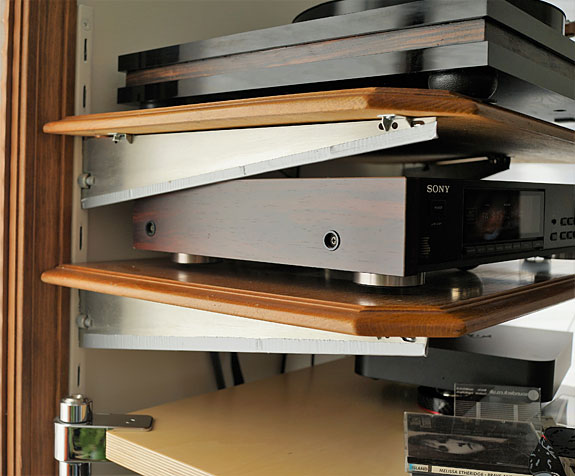
The 30mm thick, 6.6-pound platter is sized so the lip of an LP overhangs the edge for complete contact with the grooved area and to facilitate removing the LP. The platter is made of acetal copolymer, an engineering thermoplastic polymer that Bernard found to be superior to resin or acrylic. It comes with a thin, steam-pressed felt mat that did not cling to the LP when it was removed. The mat probably negates the benefit of the cut-out on the platter for the label on the LP, but — oh, well.
The table also comes with a 2mm thick, round white plastic disc with grids for cartridge alignment and overhang on one side, and stroboscope markings on the other for 33.3, 45, and 78 rpm. Moreover, there are two sets of these rings — the outer set for 50Hz cycle AC and the inner set for 60Hz AC circuits. Nice, in case you move around the planet from time to time. I find this disc also makes a wonderful dust cover for the felt mat.
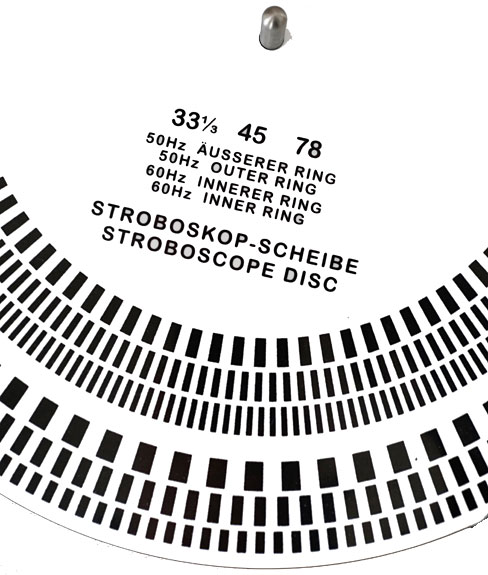
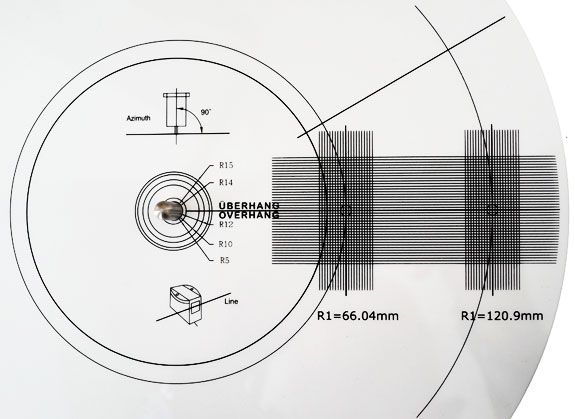
Think about it — no huge dust cover to deal with. Just an occasional wipe of the piano gloss black plinth with a microfiber cloth or a fine camel-hair paintbrush. Bernard recommends using a genuine chamois leather or an acrylic cleaning kit for cleaning. And John Hunter of REL recommends cutting off the sewn edges of microfiber cloth which can scratch the piano gloss finish.
The tonearm mounts on a raised circular acrylic armboard that is perfectly drilled for mounting and alignment of the Musiko tonearm, as you would expect. The task was so easy, even I could do it. The circular armboard is large enough for other tonearms up to 11″ in length. Bernard will also drill the armboard for different arms for an additional fee.
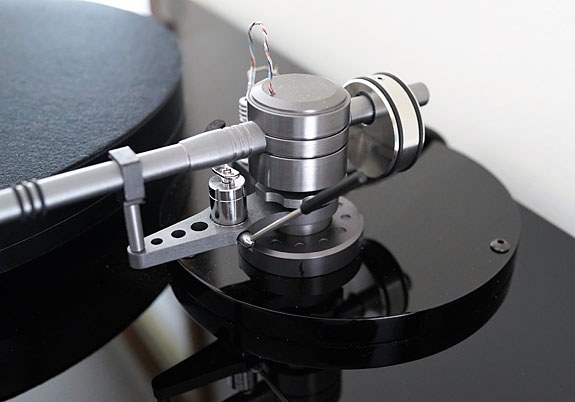
The last task, aside from aligning the cartridge, was to set up the drive belt. Except it wasn’t the ubiquitous rubber drive belt that we’re all accustomed to. No, this was one of those rare fish-line knotted belts that’s so thin they will just laugh at you when you go to LL Bean asking for an angel-hair fish line. Bernard says it’s a 0.004″ diameter polyester filament belt. I had to hunt through all the packaging just to find it. It is so thin that you can only see it when the angel twerks a certain way and the light catches it just right. It was wound around a little tab of cardboard tucked in a small zip-lock plastic bag. It’s just slightly heavier than a cobweb…but I could be wrong about that, too. The trick is not to drop it because you might not ever find it again. In case you do lose it, there is a second one wrapped around the cardboard tab.

When was the last time you ever saw this type of drive belt? Did I mention that Bernard was Old School? The spec sheet tells you how to mount it around the spindle of the custom-designed 12V DC motor and the platter. The thinner pulley at the top of the motor shaft is for 33.3 rpm and the thicker pulley right below it is for 45 rpm. You have to change the pulley each time you want to play an LP of a different speed. This is not uncommon and it avoids the extra cost of a multi-speed motor controller.
There is also a clearly labeled screw head near the motor for fine adjustment of the speed via the motor’s control board. Somehow, when you rotate the platter just right the fishline stretches just enough to fit. It didn’t take me more than a minute to figure it out, but the mystery of how that thin little line gets enough traction to pull that heavy platter up to speed in less than 10 seconds continues to elude me.
The record was always up to speed by the time the stylus hit the groove when using the cueing lever. While there was no LED to indicate the speed was locked in, I never noticed any wow & flutter, aside from that caused by the fan in a Hammond B3 organ. Sustained notes seemed as steady as a human being could play them.
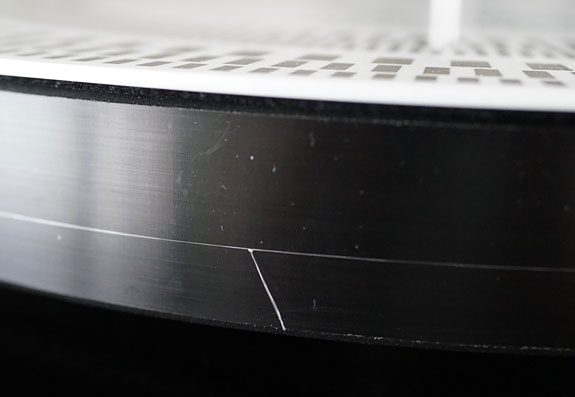
There is also the mystery of the knot in the line. Doesn’t that cause an audible bump at some point? I contacted one of my gurus to get an answer. He told me he had researched different platter weights and drive technologies. He learned that there is an ideal platter weight to best hide and smooth out audible artifacts of each type of drive train. I may not be the most golden-eared reviewer on the planet, but I heard nothing when the LP was between cuts or on the lead-out groove. And certainly, nothing when the music was playing.
If you think listening for a knot-induced noise is going to be a problem for you, well, there’s probably a 12-Step Program for you somewhere. I could just barely tell if the stylus was in contact with the LP when I cued up a record — and this was with the speaker right near the turntable. Even when I tapped on the plinth with the stylus on a silent groove, there was just the slightest audible “thump”.


Just why was that? I mentioned the box was heavy when it arrived. The plinth is comprised of three layers. The top and bottom layers are 0.75″ (19mm) thick black acrylic and the layer between them is 20mm thick Baltic birch plywood with a satin-finished band of Macassar Ebony real wood veneer. Baltic birch plywood is composed of layers of solid birch hardwood. There are no voids in the layers and there are no layers of manufactured softwoods between the birch layers. The three layers of the plinth act as constrained layer damping, along with the Sorbothane feet to block and absorb vibrations going in both directions (from the air, motor, bearing, tonearm, and the stylus/vinyl interface down into the shelf, and from the shelf upward.)
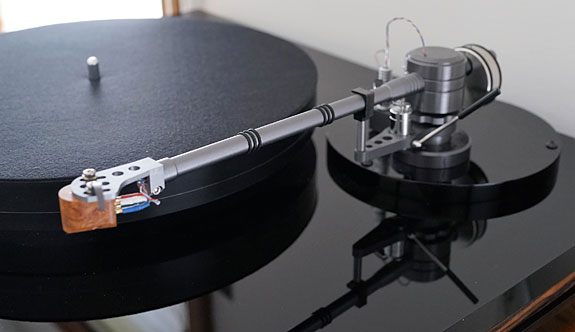
Musiko Tonearm
I’ve written about the Musiko tonearm in my Linn Project articles, but let me recap my findings in the context of this new turntable. It is a relatively unique-looking unipivot design with magnetic damping from a circular magnet encased in the pivot head. A threaded plate can be adjusted to control the amount of damping. It is still twitchy when handling it from the tonearm lift at the cartridge end of the arm. This is something that had always steered me away from unipivot arms in the past, but having used it for more than a year now, it has become a complete non-issue. And it only took me a couple of months to reach that point. I always use the lift lever to raise it and to cue up an LP, so that eliminates most of the handling danger. Once the stylus hits the LP, the arm snaps to attention and the magnetic damping seems to handle any micro-rocking.
The armrest requires a very slight nudge to set the arm in a stable resting position. The armrest does not lock it securely, however, so I keep a 3″ piece of blue painter’s masking tape handy to secure the arm to the armrest when I am adjusting or changing the cartridge.
I find the straight arm provides easy access to the platter when placing an LP on it. Since my wall-mounted shelf puts the platter just below shoulder height, this is more important than if your turntable is lower and you are looking down on the platter from above. I appreciate having the table higher up because it facilitates the cueing of inner tracks which is a frequent occurrence in the reviewing process. Not having to bend over is great.
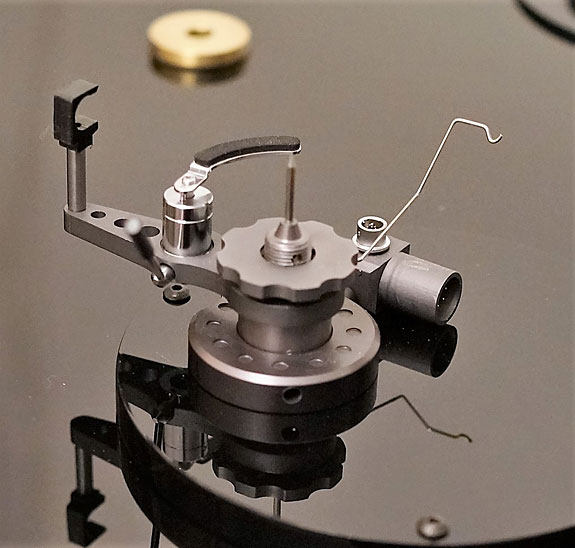
The DIN connection for the phono cables is positioned above the armboard so it requires a straight DIN connector, not an angled one. I found the Musiko tonearm cable was excellent — superior to a more expensive one I had on hand. My buddy Tom liked it so much that he bought one, too, for his Acoustic Signature table. It is available with a right-angle DIN connector if you’d like one for your current turntable.
As you might expect from this mid-priced tonearm, there is vertical (VTA) adjustment as well as azimuth adjustment with typical threaded weight. The bearings are super-smooth. There are not a lot of choices in this price range. You will likely spend multiples of its price to buy a significantly better arm. I might complain about the use of a built-in headshell instead of a removable one that would enable the use of multiple headshells with multiple cartridges to facilitate swapping cartridges. But, as you will soon read, it is hard to argue with the sonic success of this arm.
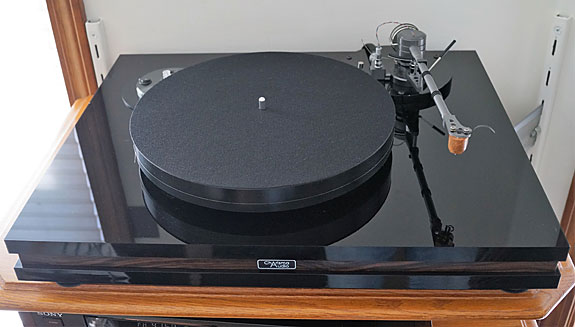
Aesthetics
We say of elegant people that they have a certain “air” about them. The Musiko turntable is an elegant turntable and it too has an air about it. There is the graceful triple-layer gloss black plinth with a formal look that is toned down by the masculine mat-gray finish of the tonearm and the more mechanically revealing design, further accented with a couple of vibration-inhibiting O-rings.
But what gives the Musiko its air of elegance is its large footprint. It commands the space surrounding the platter with a broad tuxedo-plinth that will likely dominate a shelf or the top of a rack it is likely to call home. Its 21″ x 16.5″ footprint is considerably larger than say a Rega P3 at 17.5″ x 14″. It has a presence that commands attention and proclaims you are serious about analog music. Yet it also says you are self-assured enough to know you don’t need to inflate your ego with a mountain of metal that requires multiple people to move and a stand capable of supporting a metal lathe.
Better Sound
My turntable is mounted on the front wall behind and slightly to the outside of my right speaker. It is about 4′ from the midrange driver to the phono cartridge and about 13′ from the cartridge to my listening chair. After cueing up the first LP I wasn’t halfway back to the chair when I realized the Musiko was a much better turntable than my hot-rodded LP12. We’re talking about the same Musiko tonearm, phono cables, and Charisma 103 cartridge I had been using on the LP12. Better dynamics, better resolution, more presence — even before my body hit the chair. The Charisma 103 is a major upgrade over the Denon 103 cartridge on which it is based, and a great cartridge for rock music. Dynamic, transparent, and punchy, if not the smooth cartridge you’d prefer for classical music. All of that came through in the initial listening and I was very impressed.
After a few days, a high degree of resolution began to wear on me. Bruce Springsteen’s Born in the U.S.A. in particular. It was recorded hot with either compression or clipping grating on my ears. I realized I still had the Audio Machina V8 mounted between the cartridge and tonearm. This is a marvelous device that greatly improved the resolution on my Linn. But the Linn is a suspended turntable design and the Musiko is not. Removing the V8 toned down the resolution just enough without diminishing the dynamics or transparency but a tiny bit. In fact, given the large improvement it made with the Linn, I’m surprised that removing it from the Musiko made such little difference, but it was just enough.
Of Mats & Record Weights
Another surprise came with the felt mat. With the Linn, I made huge gains by removing the felt mat and even the outer metal donut of the platter. So early on I tried removing the Musiko felt mat, placing the LP directly on the platter. There was a slight degradation, so I went back to the felt mat. The Musiko mat is different than the felt mat on the Linn. The Musiko mat appears to be steam-pressed, making it much thinner and stiffer. It also stays put on the platter and does not lift off with the LP when it is removed.
I tried three other mats I had on hand as well: a Boston Audio Design carbon graphite mat, a Soundeck mat with viscoelastic polymer between two layers of aluminum, and a Herbie’s Audio Lab Way-Excellent II mat comprised of open-cell silicone foam. While I have found each of these mats to be excellent (though slightly different) on my hot-rodded Linn, the differences each made with Musiko platter were so slight that I doubt I could reliably identify any of these aftermarket mats when compared with the supplied felt mat in a blind test. This attests to the fine qualities of the acetal copolymer used in the Musiko platter. If you have access to any of these mats, or something similar, give them a try. They might give you just the taste of sound you’re looking for, but I suspect they are much more effective on the Linn and less expensive platter types.
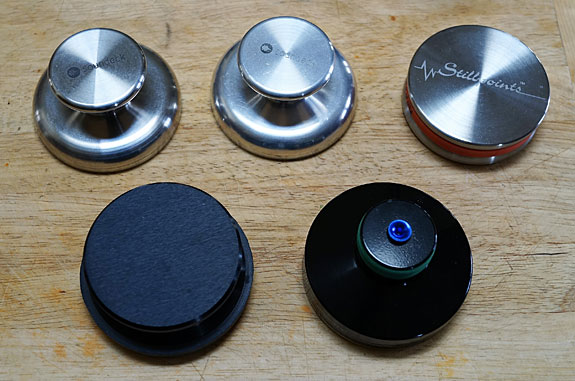
I also tried a handful of record weights in a very limited experiment — using only one song, “Makin Whoopie” from Dr. John’s In A Sentimental Mood. This is a very dynamic and transparent recording with high resolution and a variety of revealing musical elements as well as Dr. John’s gravelly voice teased with lines sweetly sung by Rickie Lee Jones. There is a lot of air, bloom, and sparkles in the treble. I played the entire song with each weight, working from heaviest to lightest.
The Synergistic Research weight (33 oz.), which was my favorite with the hot-rodded LP12, solidified the music, seemingly eliminating internal reflections within the vinyl disc. It also reduced the bloom and air in the recording. While the resolution increased, the record seemed over-damped to me.
Second, was the heavier of two Soundeck wights, this one made of stainless steel (27 oz.). Ergonomically, the Soundeck shape is a personal favorite — a very sensual polished finish with a secure grip. This one was very close to the Synergistic Research weight in sonic effect.
Third, was the Stillpoints weight (23 oz.).This one seemed to open up a bit, take on a little bloom and air, while still maintaining high resolution.
The Harmonic Resolution weight was an early version, weighing only 11 oz, but this brought back a lot of air and bloom while giving up some resolution. At the same time, some of the sparkles returned to the treble.
Fifth and final, the aluminum Soundeck weight brought back a bit more air and bloom while surrendering a touch more resolution. And, you guessed it, gained more sparkle on top.
I’m not going to tell you which was my favorite. Can a chef have too many spices? And it’s not for fear of alienating one or more manufacturers, but because there are so many other variables in anybody’s system. Even with the same set of weights and the same LP, your preference may vary. And how likely is it that you’ve got a Coincident Speaker Technologies Statement phono stage?
Bernard says he prefers it without any record weight. The important thing to draw from this is first, the record weight can make a significant difference. Second, your preference may vary. And third, heavier seems to damp more but it will be a trade-off of air and bloom for increased resolution. Like Smokey Robinson sang in 1960.
Getting Back To The Sound….
Getting back to the sound, the soundstage seemed more continuous, flowing front to back with more middle ground, rather than having performers either “up front” or “out back”. There was a wider, more continuous range of soft and loud tied in with that, provided the recording wasn’t compressed. This also carried over to greater macro and microdynamics. I mentioned the quieter surface noise on the lead-in groove and this extended to a blacker background (lower noise floor) during the recorded music. The music felt richer with more detail, more tonal colors, and an enhanced ability to follow the interplay among musicians on stage — at least as much had been encoded in the recording. The Musiko was also revealing the quality of the pressing, the quality of the recording, and the amount of record wear.
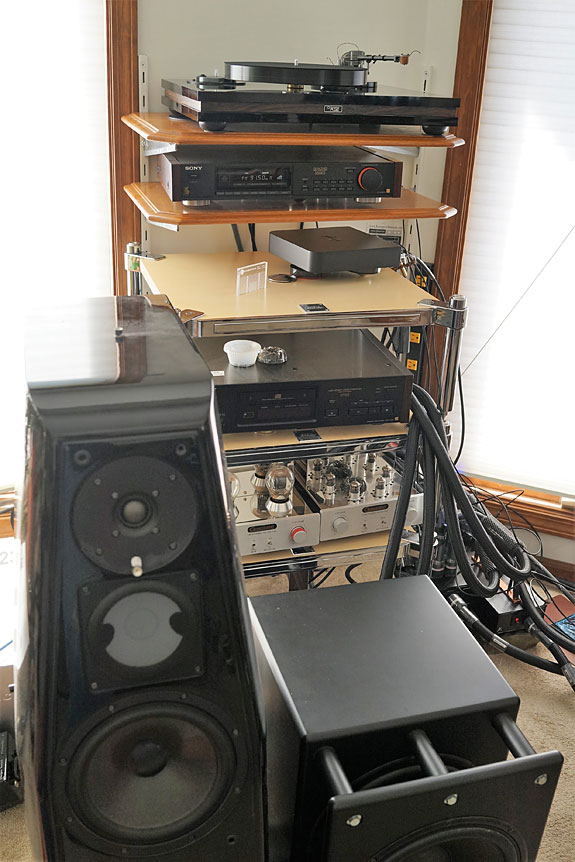
Sometime after I had set up the Musiko and begun my listening, I also reinstalled a couple of prototype Tekton Design subwoofers that I’ve had for years. This time I gave more attention to the setup and achieved much better results. While I cannot compare the results with my old Linn, I can say that the bass now goes a lot deeper and as typically happens when installing subwoofers, the mid-bass and midrange also improved. I mention this because the right subwoofer sits about 6′ from the tonearm as a cat might jump, yet I had no feedback from the subwoofer to the turntable. The Musiko is not located in a bass node, nor am I a headbanger, but the Musiko seems to be relatively immune to acoustic feedback.
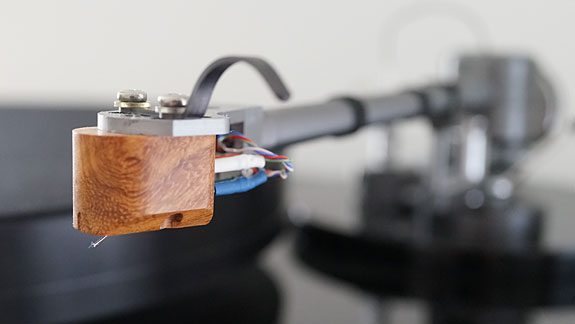
Switching cartridges to my Charisma Reference One ($2200) there was a shift in character as well as quality as you might expect for more than twice the price of the Charisma 103 ($750). The 103 is my daily driver and has served me well through years of modifying the LP12, but if you lean more toward classical, opera, and jazz, stepping up to the Reference One will bring rewards of greater resolution and a smoother presentation. You will readily hear the difference between violins, cymbals, and chorale music.
The emotional response I had to the music with either cartridge was somewhat damped by the awe this turntable and tonearm elicited. I’ve heard a lot of very expensive turntables in rigs that I could never afford at shows in Montreal, Toronto, Chicago, Denver, New York, Las Vegas, and more recently near DC. But it was captivating that I was getting so close to the very best right here in my listening room. I felt like I was mining the real music from the groove for the first time. So this is what’s been hiding in my garage sale collection all these years. Sure, the Nessie Vinylcleaner Pro does a great job of cleaning up the grunge but the Musiko makes them even quieter. Meanwhile, the toe keeps tapping away, almost unnoticed. Perhaps when the novelty of having such a high-quality analog rig wears off I will recognize how emotionally involving it truly is. For now, I’ll just have to settle for this sheepish grin I’m wearing instead of all those goosebumps. Or maybe, when my wife is out of the house, I’ll turn it up to concert level… or dig out some Motown!
Value
I can’t recall that listening with the Kronos Sparta was any more fun than listening with the Musiko, but then, my entire rig has come a long way since those days. Just switching from the complex ritual of cueing up a record on my hot-rodded LP12 with its mandatory periphery ring and heavy record weight to the simplicity of the Musiko (which didn’t get significantly better with a periphery ring), was value-added not just in dollars, but in serenity. No more Zen, no more mantra. The honor of the “biggest pain” is now bestowed upon getting the LP back in the sleeve.
If you’re stepping up from a Rega P3 or a Project Debut Pro you will have no idea of what I’m talking about here. You’ll just feel like the richest kid on the block with your new Musiko.
I had asked Bernard not to tell me the price of the table to give my mind free reign on assessing its value. I strongly suspected when listening to the first song with the Musiko that I would buy it. It was that dramatic of an improvement over what I was using. As I spent more time with it, I came to the conclusion, based on its sonic performance that the turntable alone would cost about $8000 to $8500 with a package deal with the Musiko tonearm coming in at just under $10,000. When I learned he was offering the turntable (without an arm) for $2995, I felt secretly embarrassed. But embarrassment is just a feeling, so I share it with you willingly because it conveys the value. It is a very fair price, if not an outright steal!
Summary
Bernard Li’s journey in high-end audio began as a young man in Hong Kong where he wrote reviews for the number one audio magazine, Audiotechnique. He has always been an analog fan. Now, with his successful retail and distribution company in Toronto, he has completed his dream of manufacturing a complete analog front end. He began with phono cartridges and progressed to his Musiko tonearm. The Musiko turntable now completes the package.
Without knowing the actual price, I way over-estimated the price of the table based on what I heard. A closer examination reveals a simplicity of design and knowledge of materials gained from years of experience. Bernard Li’s knowledge has far surpassed many designs requiring intricate or complex machining. The Musiko reminds me of the old saw attributed to Einstein: “Everything should be as simple as it can be, but not simpler.” He is also not burdened with the overhead of large-scale manufacturing or a dealer network. The savings are passed on to the customer.
The large footprint of the plinth and the layers of wood and acrylic give the Musiko an elegant contemporary appearance that commands attention. While it falls in the mid-price range it looks and plays like a five-figure turntable. I was preparing to spend more for it, but I will gratefully put it in play as my new reference, nonetheless. Thousands of LPs await my new analog King.
| Tonality |  |
| Sub–bass (10Hz – 60Hz) |  |
| Mid–bass (80Hz – 200Hz) |  |
| Midrange (200Hz – 3,000Hz) |  |
| High Frequencies (3,000Hz On Up) |  |
| Attack |  |
| Decay |  |
| Inner Resolution |  |
| Soundscape Width Front |  |
| Soundscape Width Rear |  |
| Soundscape Depth |  |
| Soundscape Extension Into Room |  |
| Imaging |  |
| Fit And Finish |  |
| Self Noise |  |
| Emotionally Engaging |  |
| Value For The Money |  |

Check out Enjoy the Music!
See many great reviews by Enjoy the Music.com at this link.
Specifications
Type: Vinyl LP record player / turntable
Speeds: 33.3 and 45 rpm (manually adjustable)
Motor: Servo controlled 12V DC
Thickness & Weight Of Platter: 30mm and 3 kgs.
Turntable Dimensions: 53.5cm x 42cm x 13.5cm (WxDxH)
Turntable Weight: 15 kgs.
Warranty: A limited one-year warranty against defects in material and workmanship.
Price: $2995
Type: Tonearm for vinyl LP turntable
Bearing Type: Uni-pivot
Total Mass: 1100 grams
Effective Mass: ~12 grams
Total Length: 297 mm
Effective Length: 237 mm
Mounting Distance: 222 mm
Overhang: 15 mm
Offset Angle: 21.6 degrees
Cartridge Weight: 5 to 17 grams
Limited Warranty: Limited, one year against defects in material and workmanship
Price: $2500
Company Information
Charisma Audio
Suite 86, Unit A14
4261, Highway 7
Markham, Ontario
Canada L3R 9W6
Voice: (905) 470-0825
Fax: (905) 470-7966
E-mail: charisma@rogers.com
Website: CharismaAudio.com















Want to join discussion?
Feel free to contribute!